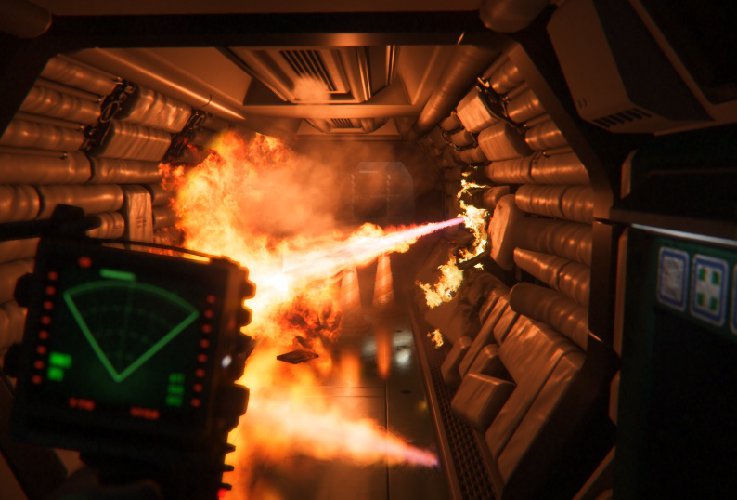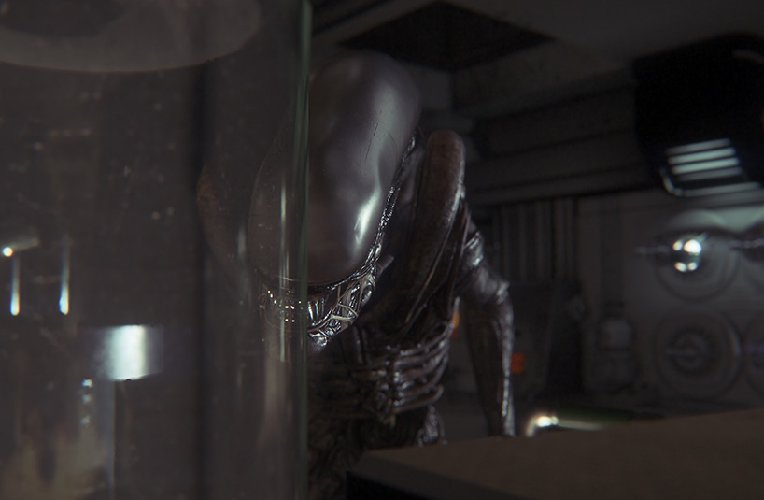What is it Like to Play Alien: Isolation on Oculus Rift?
Prepare for a xenomorph kiss through the forehead.
Good fortune smiled upon us last week in Los Angeles, as we played Sega’s Alien: Isolation twice, with the popular Oculus Rift strapped to our heads during the second demo. This marked the first time we experienced both the survival horror game and the new virtual reality device; the one Facebook paid $2 billion to acquire. Saying there’s a huge difference between the HD flat screen and VR goggles is a big understatement, but don’t worry if you can’t afford an Oculus Rift. The game will scare the hell out of you regardless.

The biggest difference between an HDTV and the Rift is depth of field and the higher level of immersion. While hiding in a storage locker, you have the usual range of movement viewing the game via television, where manipulating the analog sticks lets you look up, down, left, right and at various angles.
With the Oculus Rift, however, you can physically lean in to move closer to the locker door and stare out the slits. You also have the ability to look behind you without touching the controller. It’s an undeniably cool experience.
That said, we spent most of our time in lockers getting acclimated to using the Oculus Rift, one of the few safe places in Alien: Isolation; doing this with a drooling xenomorph in pursuit is a ticket to a quick death.

Paring the Rift with an Xbox One controller does present the player with a slight learning curve because you have to use both in tandem. With a standard TV, changing direction results in the weapon or motion tracker remaining on-screen at all times. Turning your head left or right with the Oculus Rift (as you would in the real world) leaves the aforementioned item out of view. Fail to adapt and you won’t see which direction the Alien comes from, as noted on the motion tracker.
As for the Rift itself, while the device comes with adjustable straps, we had trouble getting comfortable with our own glasses on; not to mention worried sick we’d scratch the lenses. In addition, there’s a ghosting effect that we noticed as soon as the game began, but this had more to do with training our eyes. More importantly, despite initial complaints of the screen being a lower resolution than expected, this wound up enhancing Alien: Isolation because of the game’s art direction that focuses on the 1970’s interpretation of science fiction, similar to the original Alien film. We’re in the future, but it’s appropriately crude and dirty.
Which play style did we prefer? We’ll take the easy road and say both. Oculus Rift is a promising device, no question, but there may come a point where the headset’s weight provides slight discomfort, ultimately resulting in us gently removing it to enjoy the game the old-fashioned way. For now this remains to be seen, and we thoroughly enjoyed the VR-produced adrenaline rush.

In regard to Alien: Isolation, it’s the scariest game since Dead Space and its bloody sequel. Outlast on PC and PS4 made us scream, but we eventually figured out enemy placements and developer tricks. With this game, it’s impossible to predict where the Alien will appear from, and objects like a flamethrower with limited fuel, flares and Molotov cocktails only provide brief moments of safety. You can’t run and the flashlight is almost useless. Instead, you spend the majority of time holed up in lockers and crouched behind equipment freaking out at the slightest sound. Cliché, but it’s a game of inches.
Hardcore players in search of a challenge, of course, will attempt to make things even tougher by completing levels without using the motion tracker, which is one of the in-game objectives. Not impossible to achieve, but it helps to know the environment.
After dying several times, we thought we’d get used to seeing the Alien, but the opposite was true. The creature moves so fast and is so big we immediately thought back to the most terrifying scenes from the film, particularly the one where Dallas wanders into the Alien while exploring the Nostromo air ducts; the seemingly abandoned Sevastopol Station bears a welcome resemblance to the doomed ship, right down to the air lock doors and dark industrial hallways. One moment we took an inner jaw to the head, and the next, the monster drove its razor-sharp tail through our abdomen, quickly removed it and then did something nasty to hero Amanda Ripley’s skull. At that point, there’s literally nothing you can do but watch the gruesome scene unfold, and through Oculus Rift, you have an up close and uncomfortably personal scene to digest.
We left Alien: Isolation confident that Sega and Creative Assembly’s game plays wonderfully on both flat screens and the Oculus Rift. There’s no firm release date for the latter, but the game arrives October 7th for multiple platforms. Alien fan or no, you’re in for a hair-raising treat.
